Looking for a way to fire up your major muscle groups and boost your endurance? You’re in the right place! We’re delving into the world of lower ab exercises specifically tailored for seniors.
These workouts not only improve your muscular strength but also offer remarkable cardio perks when you speed them up. To start, try exercises like seated leg raises and pelvic tilts.
These can help strengthen your core without straining your back. Then, gradually include more challenging workouts like reverse crunches or Pilates scissors for better flexibility and muscle tone. Remember to consult a fitness professional before starting any new routine to ensure it’s suitable for you.
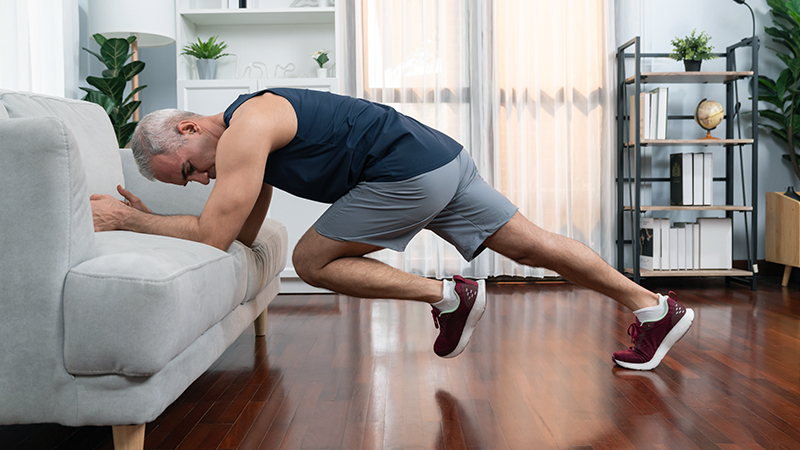
The Importance of Lower Ab Strength for Seniors
Muscle Group Engagement
Regular lower ab exercises can ignite all your major muscle groups. The bear crawl, for example, is one effective exercise that targets your critical muscles.
Speeding it up does not only pose a challenge, but it also packs some cardio perks. With time, your muscular endurance improves, setting you up for more robust daily functionality.
Oblique Workouts
Working out your obliques is not always an easy task. However, uncomplicated exercises like heel taps target your obliques in a significant way. This process induces a burn immediately, signaling muscle engagement and strength building.
Back Strength and Posture
Your back contains an essential group of muscles, the erector spinae, which assist you in standing tall. Strengthened lower abs contribute to supporting these muscles, promoting better posture and reducing the likelihood of back pain.
Improved Mobility
Your gluteal muscles, located in your buttocks, aid in crucial mobility tasks such as extending your leg, pushing off when starting a walk, or climbing stairs.
Lower ab strength greatly enhances the performance of these muscles, making daily mobility tasks easier.
Enhanced Stability
The muscles in the pelvic area, such as the iliacus, the psoas, and the quadratus lumborum, play key roles in providing stability when standing or walking.
A strengthening routine for lower abs can boost these muscles’ performance, resulting in improved balance and reduced risks of falls.
15 Effective and Safe Lower Ab Exercises for Seniors
Below, we’ve compiled a comprehensive list of 15 exercises that are not only safe and effective for seniors, but also target the lower abdominal muscles and contribute to overall health and vitality.
1. Reverse Crunch: Technique and Benefits

Engage your lower abs and improve core strength with the reverse crunch by blooming on your back, lifting your legs straight in the air and slowly curling the hips off the floor.
Boosted core strength can aid in balance stability — a boon for seniors. Additionally, the seated Russian twist is a gentle way to engage your lower abs.
Sit on the ground with bent knees and rotate your torso side-to-side. This activity enhances rotational strength, improving mobility for daily tasks.
2. L Sit-up: Steps to Perform and Advantages
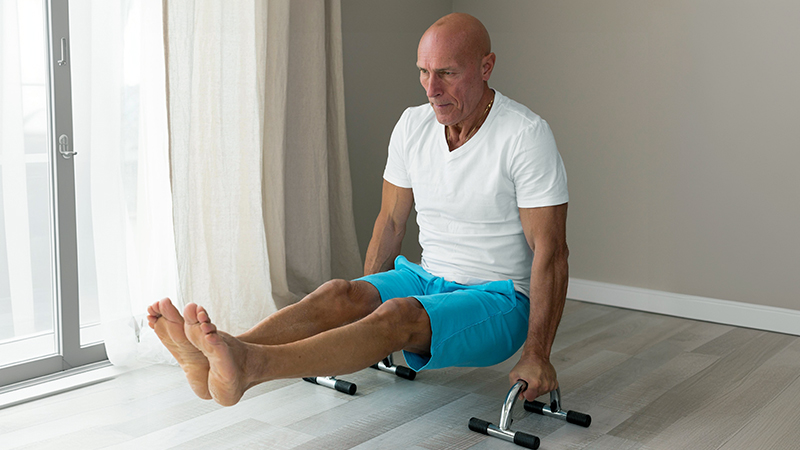
Begin in a seated position, adjust your legs into an ‘L’ shape, then perform the sit-up by lifting the torso and extending your arms forward.
This great exercise offers potential for improved mobility and flexibility, both critical as we age. Moreover, it strengthens the lower abdominal muscles and enhances core stability.
Regularly performing this exercise also aids in maintaining good posture, reducing the risk of back pain, and enhancing overall body balance for seniors.
3. Butterfly Sit-up: Correct Form and Health Rewards

Place the souls of your feet together, forming a ‘butterfly’ shape with your legs, and perform the sit-up. In addition to core strength, this move can increase the flexibility of your inner thighs, promoting overall leg health.
To perform this move safely, seniors should consider using a mat for additional back support. It’s important to keep the pace slow and controlled, avoiding jerky movements that could lead to injury. Regular practice can enhance balance and stability.
4. Hanging Leg Raises: Process and Potential Improvements

By hanging from a bar and raising your legs, you not only intensify your core engagement, but also can improve endurance and upper body strength.
5. Pike Plank: Method and Muscles Targeted
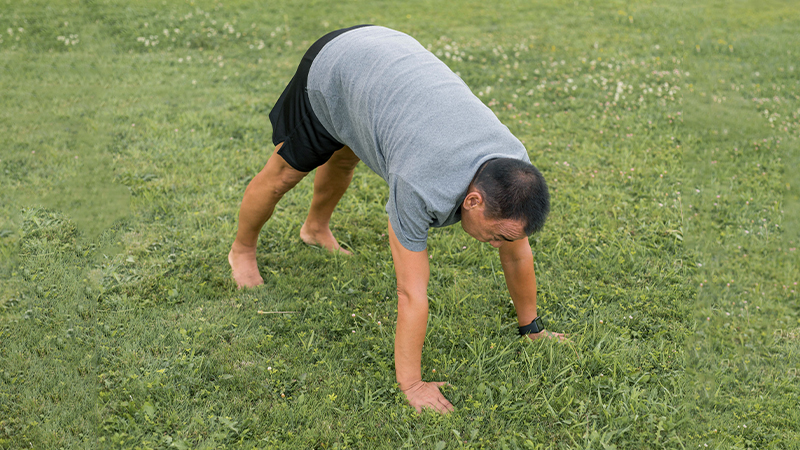
From a high plank position, elevate your hips to form a “V” shape then lower back down. This will challenge your lower abs, obliques, and total core, while also working your shoulders, a critical muscle group for stability and mobility.
Incorporating this exercise into your routine can boost overall strength and balance, reducing the risk of falls. Remember, it’s essential to maintain proper form and progress at a comfortable pace for safety.
6. High Plank Pull-Through: Procedure and Payoff

Starting in a high plank position grabbing and pulling an object from one side of the body to the other. This full-body workout hits all your abs and your obliques, fostering improved posture and stability.
Moreover, it enhances core strength which is vital for mobility and balance – crucial aspects for seniors.
To increase the challenge and effectiveness, incorporate resistance bands or light weights into your routine. Always remember, consistency is key.
7. Bear Crawl: Execution and Effectiveness
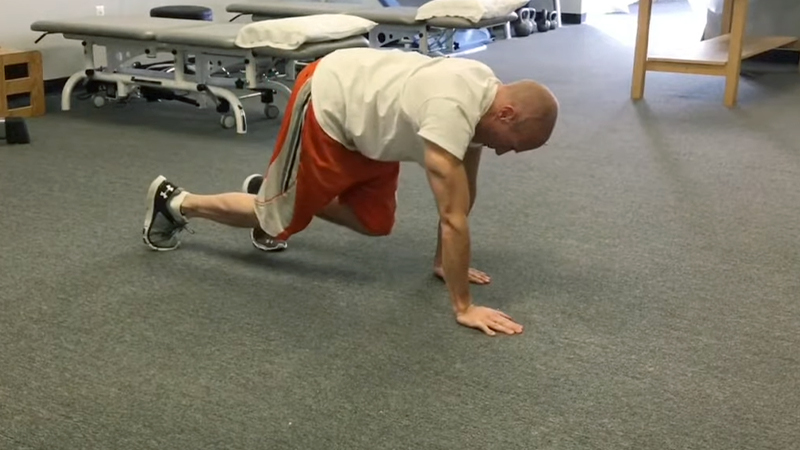
By mimicking a bear on all fours, you pack a powerful workout for your lower abs plus major muscle groups, further boosting muscular endurance.
The Bear Crawl, one such exercise, engages not only the lower abs but also your arms, shoulders, and quads. Include it in your routine to improve core strength and overall balance.
8. Horizontal Leg Lifts: Implementation and Impact

Lie flat and lift both legs to a 90-degree angle then lower them back down. This simple, yet effective move targets your lower abs and can contribute to better mobility.
Incorporating this exercise into your daily routine will improve core strength, balance, and posture.
Remember to maintain a slow pace and controlled movements to prevent injuries. A strong lower abdomen is vital for overall physical health in seniors.
9. Bicycle Crunches: Guide and Gains

With alternating knee-to-elbow touches while lying on the ground, bicycle crunches offer extensive muscle engagement —from your lower abs to your obliques, improving overall core strength.
Moreover, seated leg lifts can also help seniors strengthen their lower abs. This exercise is less strenuous yet highly effective. Likewise, the bridge pose targets the lower abs and enhances balance, key in preventing falls.
10. Rocking Abs: Directions and Deliverables

Lay down on your back, curl into a ball, and gently rock back and forth. This fun exercise can lead to enhanced core strength, better mobility, and improved balance.
Additionally, it also helps to promote better posture and reduce lower back pain. Seniors can perform this lower ab exercise safely, gradually increasing repetitions as their strength improves. Consistency is key for visible results.
11. Bosu Ball Abs: Instructions and Insights
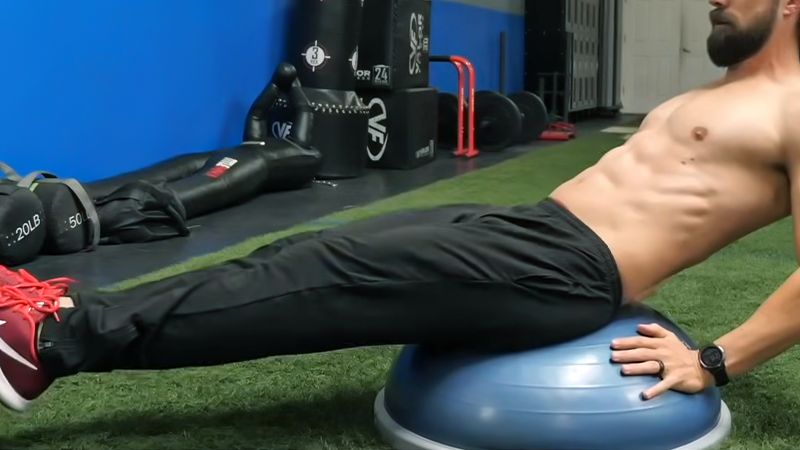
Not just for fun, the Bosu Ball can add a stability challenge to traditional sit-ups, thereby toughening your core and boosting balance.
Incorporating the Bosu Ball into your routine can increase lower ab strength, improve flexibility and enhance stability. It’s an adaptable tool perfect for seniors seeking a low-impact yet beneficial workout.
12. Dead Bug: Right Way to Do and Results
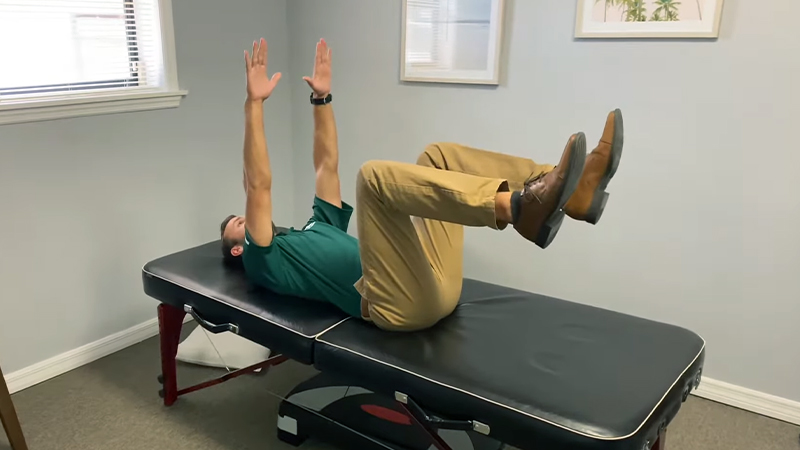
By mimicking a dead bug by lying on your back and moving your limbs, you’ll fire up your lower abs, improve core stability, and boost coordination.
Incorporate this exercise into your routine 3-4 times a week for optimal results. Remember, consistency is key in seeing progress. As you get stronger, increase the number of repetitions to challenge yourself.
13. Boat Pose: Suitable Technique and Significance

From a seated position, lean back and lift your legs, forming a “V” with your body. The boat pose is a no-equipment necessary exercise that could bolster digestive health and lower stress levels.
In addition, it targets your lower abs and improves balance. Regular practice can enhance flexibility and posture too.
However, if you have any underlying health conditions, consult with a healthcare professional before starting this exercise regimen.
14. Saw: Mastering the Move and Merits
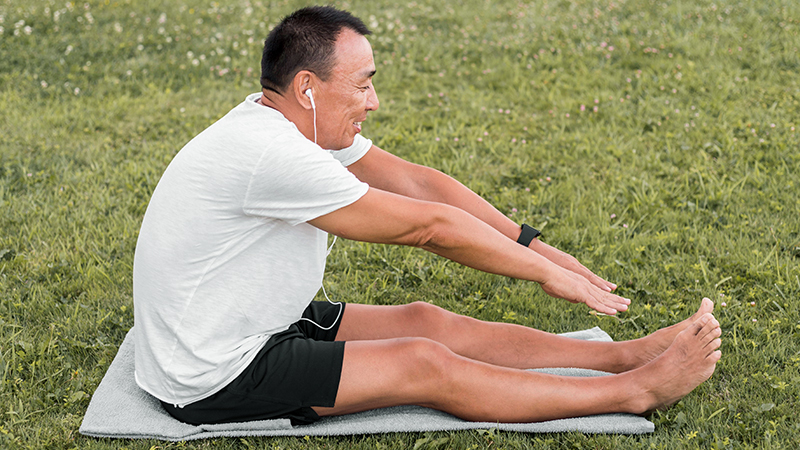
The saw move involves engaging your core and moving your body back and forth as though you were a saw. This can improve overall core strength while targeting your lower abs. Try to maintain a smooth motion, focusing on the muscle contraction rather than speed.
Regular practice of this move can aid in enhancing balance and stability, vital for seniors’ daily activities. This exercise not only strengthens your lower abs but also promotes better posture and flexibility.
15. Tap, Tap, Tap: Learning the Exercise and Benefits

On all fours, tap your hand to your opposite knee. This engaging, dynamic move fires up your obliques and targets your lower abs whilst providing a fun element to your workout.
Continue this exercise in a series of 10-15 reps per set. Remember, it’s not about speed but form and consistency.
This interaction between your upper and lower body improves balance, enhances core strength, simultaneously promoting overall fitness for seniors.
Techniques to Prevent Neck Strain During Lower Ab Exercises
When working on your lower ab muscles, it’s crucial to utilize the correct form to prevent neck strain, common in exercises like bicycle crunches, reverse crunches, and sit-ups. Here are the important techniques to remember:
Maintain Proper Positioning
Start by lying flat on your back, feet flat on the ground, and knees bent.
Support Your Head
Place your hands behind your head. Don’t interlace your fingers, as this might encourage you to pull your neck. Instead, lightly rest them at the back of your scalp, elbow wings spread wide.
Focus on the Abs
Always remember that the movement should originate from the core, not the neck. Imagine a tennis ball under your chin to create and maintain space, preventing undue strain on the neck.
Keep Your Legs Engaged
Engage your legs during the movements. Extending one leg long and rotating through your core to bring your opposite elbow toward your opposite knee engages not just the abs but also your lower body. This dual engagement prevents overstraining the neck.
Go Slow and Steady
Do your sets slow and steady – rushing might cause you to lose form and strain your neck. Do two to four sets of 10 to 16 reps.
If you need a modification, keep your feet flat on the ground and pull one knee in at a time, lifting your chest to meet your knee. And remember, the idea is to use your core muscles, not your neck or upper body, to perform the rotation.
FAQs: Lower Ab Exercises
You’ve learned about the importance of lower ab strength, the exercises that could help, and why it is key for maintaining overall body fitness particularly for seniors. Let’s delve deeper through these frequently asked questions.
1. Which are the Best Lower Ab Exercises for Seniors?
There are various lower ab exercises beneficial for seniors, but few stand out due to their low impact and high effectiveness.
- Bear Crawls: This exercise activates all the major muscle groups, improving muscular endurance. As a bonus, speeding up your bear crawls also gives you a cardio workout.
- Heel Taps: Targeting your obliques significantly, heel taps are easy to understand, do not require equipment, and deliver instant impact. Performing them correctly turns up the heat in your lower abs, letting you feel the burn right away.
Remember, it’s always advised to start workouts under expert guidance to avoid any strain or injury.
2. Are There Suitable Lower Ab Exercises for Beginner-level Seniors?
Yes, absolutely! Exercises like plank pikes and mountain climbers with gliders are excellent choices for beginner-level seniors. In both of these exercises, you start in a high plank position which is a great foundation for imparting core strength. With continuous practice, you can level up the intensity by quickening the pace or giving variations to these exercises.
Another ideal exercise is the saw, performed with gliders or towels. It strengthens your core by elongation rather than contraction, making it an effective workout for beginners.
As a beginner, it is crucial to observe your body reactions and mold your workout routine accordingly, gradually increasing the intensity.
3. How Long Does it Take to See Results from Lower Ab Workouts for Seniors?
The timeline to see visible results from lower ab workouts can range anywhere between 4 to 12 weeks. However, the exact timeframe depends on a variety of factors including the initial fitness level, frequency and intensity of workouts, diet, and overall lifestyle habits.
It should be noted that any physical fitness routine, including lower ab workouts, should be accompanied by a balanced diet and healthy lifestyle for optimum results.
Remember, the journey to fitness is not a sprint, but a marathon. Be patient, stay consistent, and results will follow.
Conclusion: Embracing Fitness at All Ages
You’ve seen how lower ab exercises can be a game-changer for seniors. They’re not just about getting a toned tummy.
They’re about enhancing your overall health, stability, and mobility. From bear crawls to heel taps, these exercises can improve your posture, support your back muscles, and strengthen your pelvic area. Even better, they’re safe and easy to do right at home.
Remember, it’s not about rushing to see results. It’s about consistency and gradual progression. Listen to your body and seek expert guidance when needed. With the right approach, you can reap the benefits and see improvements in your fitness journey.
So, don’t let age be a barrier to fitness. Embrace these lower ab exercises and make them a part of your routine. After all, fitness knows no age limit. Stay active, stay fit, and enjoy the journey to a healthier you.
I am a fitness instructor and I have been in the industry for 9 years. I have a passion for health and fitness.
I am a fitness instructor with over 9 years of experience in the industry. My passion is health and fitness and I would love to share my knowledge with you!